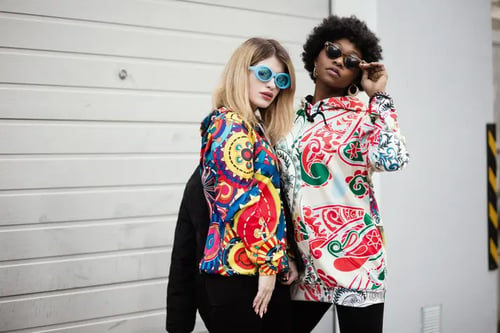.png)
Your Comprehensive Guide to Diversity and Inclusion in Market Research
“Diversity” and “inclusion” have become undeniably big buzz words in the market research sector in recent years.
However, as stated by Jane Frost, CEO of MRS, they mean something very simple: Everyone belongs.
Indeed, The MRS Inclusion Pledge and Diversity and Inclusion Best Practice Guides in particular have sparked inspiration for those working within the field to re-evaluate and/or bolster their inclusive research practices.
With that in mind, we’ve dedicated this blog to exploring exactly what is meant by diversity and inclusion within the context of market research, as well as sharing inclusive research practices that you can implement within your organisation and processes for ultimate success.
First of all... what do we mean by diversity and inclusion?
By definition (according to The Global Diversity Practice), diversity is about “empowering people by respecting and appreciating what makes them different, in terms of age, gender, ethnicity, religion, disability, sexual orientation, education and national origin.”
Inclusion, respectively, is “an organisational effort and practices in which different groups or individuals having different backgrounds are culturally and socially accepted and welcomed.”
So, in the context of market research, this means empowering and accepting all those who encounter the sector, regardless of their unique identity; whether that’s your market research respondents, those conducting the research, or another individual or organisation’s team entirely.

And how can you embrace diversity and inclusion within your market research projects?
1. Start with your own teams
The best starting point is ensuring that your own brand and/or research teams and practices fully embrace diversity and inclusion. After all, as stated by Jane Frost:
“If we truly are a window on the world, as we claim to be, we cannot really do a good job if the people who are making those decisions and taking those insights and interpreting that data are not fully representative of the world on which we report.”
Plus, according to the GRBN Global Diversity, Equality & Inclusivity (DEI) Survey, 30% of people in the market research industry think that everyone does not have equal status, and there is a negative feeling overall about the diversity of the employee base where they work, more so than the general population.
In fact, 67% of market research employees would like to incorporate more cultural insights across diverse communities and be more representative in their work overall.
In short, it’s all about ensuring that your business and processes embrace diversity and inclusion at every possible opportunity.
This includes your internal hiring processes, ensuring that you hire people from all walks of life who are just as knowledgeable and passionate about diversity and inclusion as you are. This also means providing regular, continuous training for your current employees around diversity and inclusion; both in terms of general day-to-day work, and through inclusive research practices.
It’s also important to ensure that, in light of the statistics above, all your employees are given equal opportunities for experience and growth.
Finally, as stated by Gill Barr in The State of DE&I in Market Research and the Way Forward debate at MRS Impact 2022:
“It’s also important to let your teams know about the diversity and inclusion practices you implement across your business, and leave a door wide open for employees to share and discuss what is working well, and what could be done better to promote and embrace diversity and inclusion.”
In sum, the more knowledgeable, understanding and empathetic to diversity and inclusion that your employees and business can be, and the more equally they are (and feel) treated by your business, the more representative your market research insights will be.
Plus, it’s significantly more likely that your teams will feel fulfilled in their own roles!
2. Next, review your current market research practices
Once you’ve reviewed the diversity and inclusion of your internal teams, it’s time to look at your market research tools and practices specifically, and how you can make them more inclusive and representative of the population as a whole.
This includes evaluating your:
Recruitment techniques
There are several different recruitment methods you can use to find market research participants. However, in order to make your recruitment as diverse and inclusive as possible, you need to consider the pros and cons of each one, and combine the best strengths of each for optimum results.
For example, while paid social media adverts enable you to target a whole host of demographics, some of those demographics are less likely to use social media and see those adverts in the first place.
In which case, the use of methods such as word of mouth and picking up the phone might help this reach!
You’ll also need to thoroughly review your market research recruitment validation procedures, including screeners, to ensure that you have as highly representative a sample as possible. This means including questions on age, gender, ethnicity, religion, disability, sexual orientation, education and national origin.
You should also make sure to make these processes accessible within themselves; for example, offering an alternative to phone validations for those who have a hearing impairment
Market research methodologies
There’s a variety of research methods you can use to gather insights from your participants; however, some may not cater well to certain demographics.
For example, a market research online community is a fantastic way to gather people from all over the country; however, not everyone will have the same access to and/or confidence to use the technology needed to get involved, and may therefore be unable to participate.
Plus, while face-to-face focus groups are brilliant for in-depth discussions between participants, they might be more difficult for people with accessibility needs to attend.
So, you may need to consider a combination of these methodologies to ensure your research enables as many people from different background to get involved as possible.

3. Finally, choose providers or partners who also have clear diversity and inclusion values and practices
Once your internal processes have been initially reviewed and amended, it’s time to consider the work you do with external partners in the market research process and ensure that their own inclusive research practices hit the mark.
For example, at Angelfish Fieldwork, we’ve made it our mission to ensure that we stay on top of the latest information, guidance and advice on diversity and inclusion in the market research sector; from attending webinars and events to following MRS’s diversity and inclusion guides, plus more.
We are also committed to putting those learnings into practice; firstly, all participants who join the Angelfish Community are asked to share as much detail as is necessary regarding their demographics to get involved in our clients’ projects.
This is not only so that our clients can recruit a truly diverse and inclusive sample, but so that individuals with different backgrounds, experiences and more have equal opportunities to share their opinions and get their voices heard.
What’s more, our screeners always include diversity and inclusion questions, so that when it comes to finding participants for our clients’ projects, we can ensure that they have as representative a sample as possible.
Ready to start implementing diverse and inclusive research practices in your projects?
We’d be delighted to support you with this at Angelfish Fieldwork! People are, after all, our passion, and ensuring that every person has an equal opportunity to have their voice heard and their needs met through market research – as well as enabling you to get the best and most implementable insights for your brand – are our ultimate goals!
Simply contact us today to let us know more about your market research project, and we’ll be in touch to discuss your needs and how we can help your study soar...














